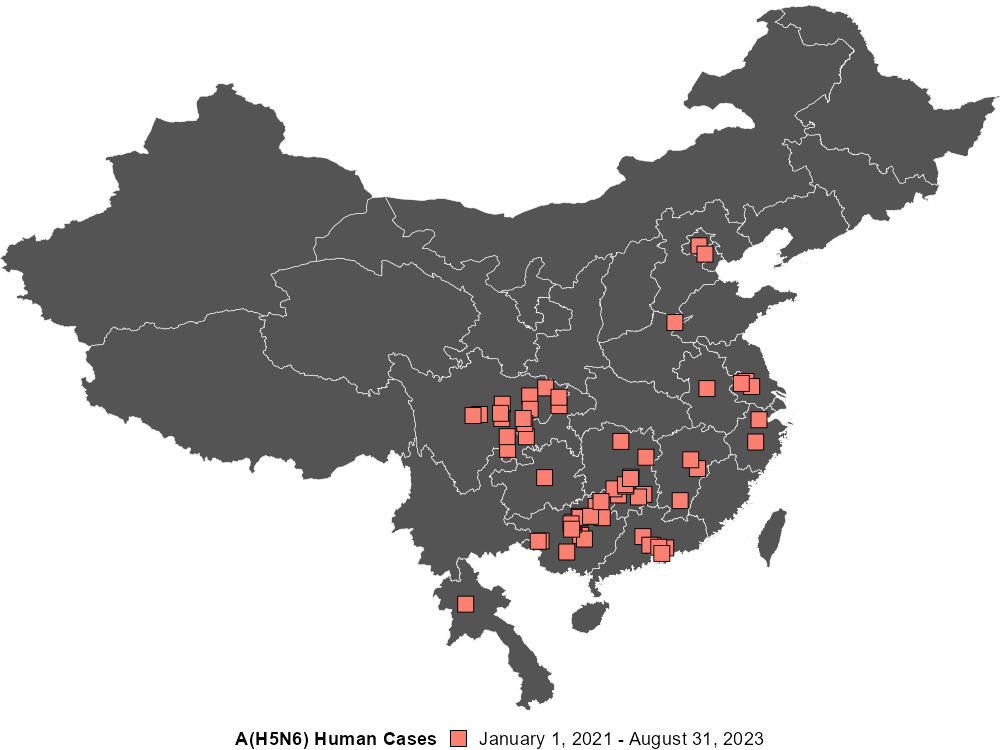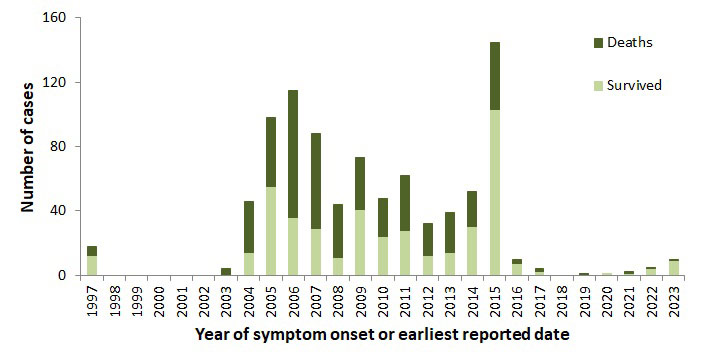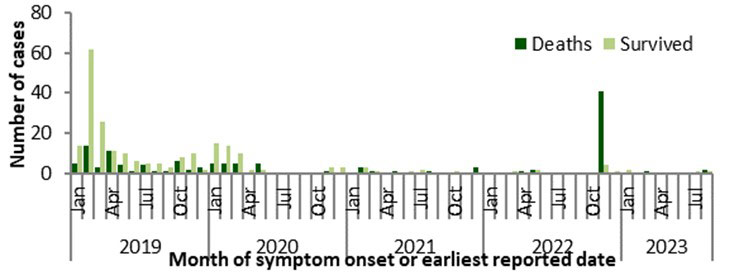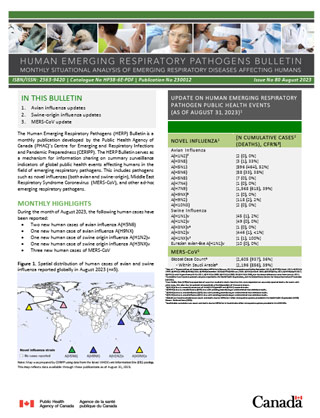Human emerging respiratory pathogens bulletin: Issue 80, August 2023
Download in PDF format
(572 KB, 3 pages)
Organization: Public Health Agency of Canada
Date published: 2023-09-12
Monthly situational analysis of emerging respiratory diseases affecting humans (data to August 31, 2023).
In this bulletin
- Avian influenza updates
- Swine influenza updates
- Middle East respiratory syndrome coronavirus (MERS-CoV) update
| Novel influenzaFootnote 1 | Cumulative Case CountFootnote 2 | Deaths | Case Fatality Rate %Footnote 3 |
|---|---|---|---|
| Avian Influenza | |||
| A(H1N2)Footnote 4 | 2 | 0 | 0% |
| A(H3N8) | 3 | 1 | 33% |
| A(H5N1) | 896 | 464 | 52% |
| A(H5N6) | 88 | 33 | 38% |
| A(H5N8) | 7 | 0 | 0% |
| A(H7N4) | 1 | 0 | 0% |
| A(H7N9) | 1,568 | 615 | 39% |
| A(H9NX)Footnote 5 | 1 | 0 | 0% |
| A(H9N2) | 118 | 2 | 2% |
| A(H10N3) | 2 | 0 | 0% |
| Swine Influenza | |||
| A(H1N1)v | 45 | 1 | 2% |
| A(H1N2)v | 49 | 0 | 0% |
| A(H3NX)vFootnote 6 | 1 | 0 | 0% |
| A(H3N2)v | 446 | 1 | <1% |
| A(H1NX)vFootnote 7 | 1 | 1 | 100% |
| Eurasian avian-like A(H1N1)v | 10 | 0 | 0% |
| MERS-CoVFootnote 1 | Cumulative Case CountFootnote 2 | Deaths | Case Fatality Rate %Footnote 3 |
| Global Case CountFootnote 8 | 2,605 | 937 | 36% |
| - Within Saudi ArabiaFootnote 9 | 2,196 | 856 | 39% |
Footnotes
|
|||
The Human Emerging Respiratory Pathogens (HERP) Bulletin is a monthly publication developed by the Public Health Agency of Canada (PHAC)'s Centre for Emerging and Respiratory Infections and Pandemic Preparedness (CERIPP). The HERP Bulletin serves as a mechanism for information sharing on summary surveillance indicators of global public health events affecting humans in the field of emerging respiratory pathogens. This includes pathogens such as novel influenzas (both avian and swine-origin), Middle East Respiratory Syndrome Coronavirus (MERS-CoV), and other ad-hoc emerging respiratory pathogens.
Monthly Highlights
During the month of August 2023, the following human cases have been reported:
- Two new human cases of avian influenza A(H5N6)
- One new human case of avian influenza A(H9NX)
- One new human case of swine origin influenza A(H1N2)v
- One new human case of swine origin influenza A(H3NX)v
- Three new human cases of MERS-CoV

Figure 1 - Text description
Two (2) A(H5N6) cases were reported in China.
One (1) A(H9NX) case was reported in China.
One (1) A(H1N2)v case was reported in the United States.
One (1) A(H3NX)v case was reported in the United States.
Note: Map was prepared by CERIPP using data from the latest WHO Event Information Site (EIS) postings. This map reflects data available through these publications as of August 31, 2023.
Avian influenza updates
Avian influenza A(H5N1)
The most recent human cases of avian influenza A(H5N1) were reported in July 2023 from the United Kingdom.
Since 2022, 15 human cases of A(H5N1) have been reported worldwide (2022 n=5, 2023 n=10) in Cambodia (2), Chile (1), China (2), Ecuador (1), Spain (2), United Kingdom (5), United States (1), Vietnam (1). Of these cases, 13 belonged to clade 2.3.4.4b and two belonged to clade 2.3.2.1c (both from Cambodia). Since the emergence of A(H5N1) in humans in 1997, 896 human cases of A(H5N1) have been reported globally, with a CFR of 52%.
In Canada, a significant number of A(H5N1) detections associated with the current 2021-2023 A(H5N1) clade 2.3.4.4b epizootic have been reported in domestic, backyard, and wild bird populations, as well as other animal species. No domestically acquired human A(H5N1) infections have ever been reported in Canada. In 2014, Canada (Alberta) reported a single fatal case of A(H5N1) in a resident returning from travel in China.
Avian influenza A(H5N6)
Two new human cases of avian influenza A(H5N6) were reported in August 2023 from China and both cases were from Sichuan Province, China. One case was a male from Chongqing Municipality whose age was unknown. He was in critical condition as of the time of last report, and was exposed to two dead chickens prior to illness onset. The other case was a 27-year-old female who was hospitalized with severe pneumonia. She had exposure to a poultry farm located in Dazhou Municipality. Environmental samples tested positive for A(H5N6). As of the time of last report, no close contacts have developed symptoms of illness.
In 2023, five human cases of avian influenza A(H5N6) have been detected. A total of 88 laboratory-confirmed human cases of avian influenza A(H5N6), including at least 33 deaths (CFR: 38%) have been reported globally since 2014. Since January 2021, 62 cases of avian influenza A(H5N6) have been reported globally; 32 cases in 2021, 25 cases in 2022 and five cases in 2023 (Figure 2); the majority of cases (61) were reported from China and one case was reported from Lao PDR (Figure 3). No cases have been reported in Canada.
Avian influenza A(H9NX)
One new human infection of avian influenza A(H9NX) was reported in August 2023 in China. The case was a 4-year-old female from Sichuan Province, and she had an illness onset date of August 7, 2023. No additional case details were available as of the time of last report.
Not including this case, in 2023, 11 human cases of avian influenza A(H9N2) have been reported globally. Since the emergence of this virus in the human population in 1998, 118 cases have been reported worldwide, with a CFR of 2%. No cases have been reported in Canada.

Figure 2 - Text description
| Year | Month | Cases |
| 2021 | Jan | 1 |
| Feb | 2 | |
| Mar | 2 | |
| Apr | 0 | |
| May | 0 | |
| June | 1 | |
| July | 4 | |
| Aug | 6 | |
| Sep | 6 | |
| Oct | 4 | |
| Nov | 0 | |
| Dec | 6 | |
| 2022 | Jan | 8 |
| Feb | 6 | |
| Mar | 3 | |
| Apr | 3 | |
| May | 1 | |
| June | 1 | |
| July | 0 | |
| August | 0 | |
| Sep | 1 | |
| Oct | 1 | |
| Nov | 0 | |
| Dec | 1 | |
| 2023 | Jan | 0 |
| Feb | 0 | |
| Mar | 1 | |
| Apr | 0 | |
| May | 1 | |
| June | 0 | |
| July | 1 | |
| August | 2 |
Note: Graph was prepared by CERIPP using data from the WHO EIS postings and the Hong Kong Centre for Health Protection (CHP) press releases. This graph reflects data available as of August 31, 2023.

Figure 3 - Text description
- Four cases were reported out of Yongzhou, Hunan Province, People's Republic of China.
- Four cases were reported out of Guilin, Guangxi Zhuang Autonomous Region, People's Republic of China.
- Three cases were reported out of Huizhou, Guangdong Province, People's Republic of China.
- Three cases were reported out of Liuzhou, Guangxi Zhuang Autonomous Region, People's Republic of China.
- Two cases were reported out of Baise, Guangxi Zhuang Autonomous Region, People's Republic of China.
- Two cases were reported out of Chengdu, Sichuan Province, People's Republic of China.
- Two cases were reported out of Chenzhou, Hunan Province, People's Republic of China.
- Two cases were reported out of Dongguan, Guangdong Province, People's Republic of China.
- Two cases were reported out of Guangxi Zhuang Autonomous Region, People's Republic of China.
- Two cases were reported out of Hechi, Guangxi Zhuang Autonomous Region, People's Republic of China.
- Two cases were reported out of Hengyang, Hunan Province, People's Republic of China.
- Two cases were reported out of Jiangxi Province, People's Republic of China.
- Two cases were reported out of Sichuan Province, People's Republic of China.
- Two cases were reported out of Tongnan District, Chongqing Municipality, People's Republic of China.
- Two cases were reported out of Zhenjiang, Jiangsu Province, People's Republic of China.
- One case was reported out of Anhui Province, People's Republic of China.
- One case was reported out of Bazhong, Sichuan Province, People's Republic of China.
- One case was reported out of Changde, Hunan Province, People's Republic of China.
- One case was reported out of Deyang City, Sichuan Province, People's Republic of China.
- One case was reported out of Fuzhou, Fujian Province, People's Republic of China.
- One case was reported out of Ganzhou City, Jiangxi Province, People's Republic of China.
- One case was reported out of Guizhou Province, People's Republic of China.
- One case was reported out of Hangzhou, Zhejiang Province, People's Republic of China.
- One case was reported out of Kaijiang County, Sichuan Province, People's Republic of China.
- One case was reported out of Laibin, Guangxi Zhuang Autonomous Region, People's Republic of China.
- One case was reported out of Langzhong City, Sichuan Province, People's Republic of China.
- One case was reported out of Luang Prabang Province, Lao People's Democratic Republic (the).
- One case was reported out of Nanning, Guangxi Zhuang Autonomous Region, People's Republic of China.
- One case was reported out of Puyang City, Henan Province, People's Republic of China.
- One case was reported out of Xuanhan County, Sichuan Province, People's Republic of China.
- One case was reported out of Yangzhou, Jiangsu Province, People's Republic of China.
- One case was reported out of Yibin, Sichuan Province, People's Republic of China.
- One case was reported out of Yongchuan District, Chongqing Municipality, People's Republic of China.
- One case was reported out of Zhejiang Province, People's Republic of China.
- One case was reported out of Zigong City, Sichuan Province, People's Republic of China.
- One case was reported out of Nanning, Guangxi Province, People's Republic of China.
- One case was reported out of Guangxi Zhuang Autonomous Region, People's Republic of China.
- One case was reported out of Changsa, Hunan Province, People's Republic of China.
- One case was reported out of Qingyuan, Guangdong Province, People's Republic of China.
- Two cases were reported out of Sichuan Province, People's Republic of China.
Note: Map was prepared by CERIPP using data from the WHO EIS postings and the Hong Kong CHP press releases. This map reflects data available through these publications as of August 31, 2023.

Figure 4 - Text description
| Year | Number of Cases | Deaths | Survived |
|---|---|---|---|
| 1997 | 18 | 6 | 12 |
| 1998 | 0 | 0 | 0 |
| 1999 | 0 | 0 | 0 |
| 2000 | 0 | 0 | 0 |
| 2001 | 0 | 0 | 0 |
| 2002 | 0 | 0 | 0 |
| 2003 | 4 | 4 | 0 |
| 2004 | 46 | 32 | 14 |
| 2005 | 98 | 43 | 55 |
| 2006 | 115 | 79 | 36 |
| 2007 | 88 | 59 | 29 |
| 2008 | 44 | 33 | 11 |
| 2009 | 73 | 32 | 41 |
| 2010 | 48 | 24 | 24 |
| 2011 | 62 | 34 | 28 |
| 2012 | 32 | 20 | 12 |
| 2013 | 39 | 25 | 14 |
| 2014 | 52 | 22 | 30 |
| 2015 | 145 | 42 | 103 |
| 2016 | 10 | 3 | 7 |
| 2017 | 4 | 2 | 2 |
| 2018 | 0 | 0 | 0 |
| 2019 | 1 | 1 | 0 |
| 2020 | 1 | 0 | 1 |
| 2021 | 2 | 1 | 1 |
| 2022 | 5 | 1 | 4 |
| 2023 | 10 | 2 | 8 |
Note: Graph was prepared by CERIPP using data from the WHO EIS postings, the US CDC's Health Alert Network (HAN), and WHO cumulative case counts. This graph reflects data available as of August 31, 2023.
Swine influenza updates
Swine origin influenza A(H1N1)v
The most recent human case of swine origin influenza A(H1N1)v was reported in June 2023 in Brazil.
There have been four human A(H1N1)v cases reported worldwide in 2023. A total of 45 human cases of A(H1N1)v have been reported globally since 2005, with a 2% CFR. Two A(H1N1)v detections have been reported in Canadian residents since reporting began in 2005, with the first case reported in Ontario in September 2012 and the second case reported in Manitoba in April 2021 (see HERP Bulletin #52).
Swine origin influenza A(H1N2)v
One human case of swine origin influenza A(H1N2)v was reported in August 2023 from the United States. The case was under 18 years old and attended an agricultural fair in Tuscola County, Michigan. The case was not hospitalized, received antiviral treatment, and had recovered from the infection. No human-to-human transmission associated with this case has been identified.
There have been two human swine origin influenza A(H1N2)v cases reported worldwide in 2023. A total of 49 human cases of swine origin influenza A(H1N2)v have been reported globally since 2005, with a 0% CFR. Three swine origin influenza A(H1N2)v detections have been reported in Canadian residents since reporting began in 2005, and the latest case in Canada was reported in November 2021 in Manitoba (see HERP Bulletin #59).
Swine origin influenza A(H3NX)v
One putative human case of infection with swine origin influenza A(H3) was reported from the United States in August 2023. The case was under 18 years of age, was not hospitalized, received antiviral treatment, and recovered from the infection. This case attended an agricultural fair in Oakland county, Michigan. This agricultural fair was geographically different from the fair attended by the case who tested positive for A(H1N2)v.
No cases of swine origin influenza A(H3N2)v have been detected in 2023. Excluding this case, globally, 446 swine origin influenza A(H3N2)v cases have been reported since 2005, with <1% CFR. Two swine origin influenza A(H3N2)v detections have been reported in Canadian residents since reporting began in 2005, with the latest case reported in June 2021 (see HERP Bulletin #54).
Middle East respiratory syndrome coronavirus (MERS-CoV) update
Three human cases of MERS-CoV were reported from Saudi Arabia in August 2023. These cases occurred between November 2022 and January 2023 and were reported from three different regions: Riyadh, Asser, and Makkah Al Mukarramah. The cases were 42-, 83-, and 85-years old, respectively. All cases were male, non-health care workers who had comorbidities. All cases were admitted to the intensive care unit (ICU), where two died and one recovered. Two of the cases reported contact with camels and all cases consumed raw camel milk prior to symptom onset. No secondary cases related to any of the three cases were identified.
In 2023, seven cases of MERS-CoV were reported. According to the WHO, 2,605 laboratory-confirmed cases of MERS-CoV, including 937 deaths, have been reported globally since reporting began in 2012 (CFR: 36%). No cases have ever been reported in Canada.

Figure 5 - Text description
| Year | Month | Deaths | Survived |
|---|---|---|---|
| 2019 | Jan | 5 | 14 |
| Feb | 14 | 62 | |
| Mar | 3 | 26 | |
| Apr | 11 | 11 | |
| May | 4 | 10 | |
| June | 1 | 6 | |
| July | 4 | 5 | |
| Aug | 1 | 5 | |
| Sep | 1 | 3 | |
| Oct | 6 | 8 | |
| Nov | 2 | 10 | |
| Dec | 3 | 2 | |
| 2020 | Jan | 5 | 15 |
| Feb | 5 | 14 | |
| Mar | 5 | 10 | |
| Apr | 0 | 2 | |
| May | 5 | 2 | |
| June | 0 | 0 | |
| July | 0 | 0 | |
| Aug | 0 | 0 | |
| Sep | 0 | 0 | |
| Oct | 0 | 0 | |
| Nov | 1 | 3 | |
| Dec | 0 | 3 | |
| 2021 | Jan | 0 | 0 |
| Feb | 3 | 3 | |
| Mar | 1 | 1 | |
| Apr | 0 | 0 | |
| May | 1 | 0 | |
| June | 0 | 1 | |
| July | 0 | 2 | |
| Aug | 1 | 0 | |
| Sep | 0 | 0 | |
| Oct | 0 | 1 | |
| Nov | 0 | 0 | |
| Dec | 3 | 0 | |
| 2022 | Jan | 0 | 0 |
| Feb | 0 | 0 | |
| Mar | 0 | 1 | |
| Apr | 1 | 0 | |
| May | 2 | 2 | |
| June | 0 | 0 | |
| July | 0 | 0 | |
| August | 0 | 0 | |
| Sep | 0 | 0 | |
| Oct | 0 | 0 | |
| Nov | 41 | 4 | |
| Dec | 0 | 1 | |
| 2023 | Jan | 0 | 2 |
| Feb | 0 | 0 | |
| Mar | 1 | 1 | |
| Apr | 0 | 0 | |
| May | 0 | 0 | |
| June | 0 | 0 | |
| July | 0 | 1 | |
| August | 2 | 1 |
Note: Graph was prepared by CERIPP using data from the WHO Disease Outbreak News (DON) and Saudi Arabia's Ministry of Health. This graph reflects data available as of July 31, 2023. The data integrates CERIPP real-time reporting with WHO DON retrospective reporting of MERS-CoV cases and deaths. In November 2022, the WHO published a DON article that updated their counts with retrospective cases and deaths, which resulted in an increase of an additional 5 cases and 41 deaths compared to their previous MERS-CoV-related DON. In August 2023, the WHO published a DON article with case information for three retrospective MERS-CoV cases and two deaths. These three cases and one death were already reflected in the cumulative case count of the DON article published in July 2023, as well as the case totals published in HERP Bulletin #79.
